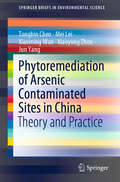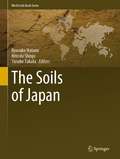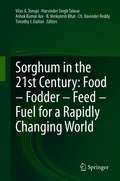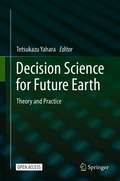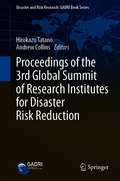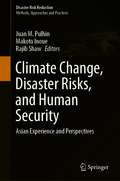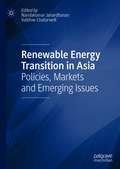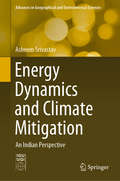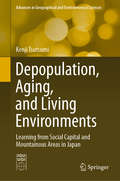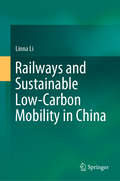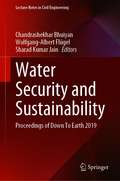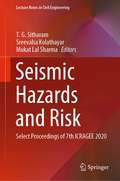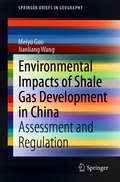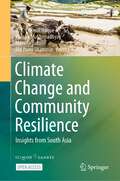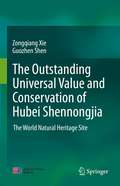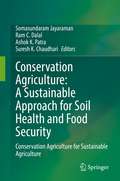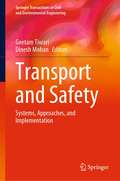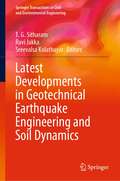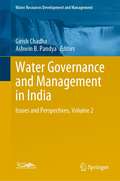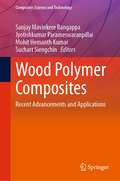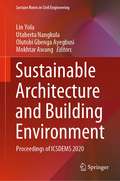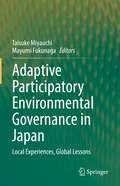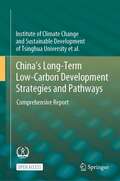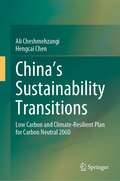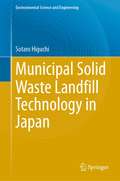- Table View
- List View
Phytoremediation of Arsenic Contaminated Sites in China: Theory and Practice (SpringerBriefs in Environmental Science)
by Tongbin Chen Mei Lei Xiaoming Wan Xiaoyong Zhou Jun YangThis book introduces readers to the main theories of phytoremediation and its application to arsenic-contaminated soils in China. The hyperaccumulation theories are introduced, including the use of hyperaccumulators to remove large amounts of arsenic without producing toxic symptoms. The use of synchrotron-based X-ray absorption fine structure radiation to disclose the hyperaccumulation mechanism – a method that makes it possible to detect the elements in plant tissues without destroying the sample – is introduced in detail. This book also includes practical application cases of phytoremediation, which are rarely found in the literature. Allowing readers to gain a thorough understanding of phytoremediation technology, and demonstrating its efficiency in cleaning arsenic-contaminated soils, the book offers a valuable asset for graduate students, lecturers, researchers and engineers in the field of soil remediation.
The Soils of Japan (World Soils Book Series)
by Ryusuke Hatano Hitoshi Shinjo Yusuke TakataThis book provides an overview of the distribution, properties, and function of soils in Japan. First, it offers general descriptions of the country’s climate, geology, geomorphology, and land use, the history of the Japanese soil classification system and characteristics and genesis of major soil types follow. For each region – a geographic/administrative region of the country – there is a chapter with details of current land use as well as properties and management challenges of major soils. Maps of soil distribution, pedon descriptions, profile images, and tables of properties are included throughout the text and appendices.
Sorghum in the 21st Century: Food – Fodder – Feed – Fuel for a Rapidly Changing World
by Vilas A. Tonapi Harvinder Singh Talwar Ashok Kumar Are B. Venkatesh Bhat Ch. Ravinder Reddy Timothy J. DaltonSorghum is the most important cereal crop grown in the semi-arid tropics (SAT) of Africa, Asia, Australia and Americas for food, feed, fodder and fuel. It is the fifth most important cereal crop globally after rice, wheat, maize and barley, and plays a major role in global food security. Sorghum is consumed in different forms for various end-uses. Its grain is mostly used directly for food purposes. After the release of the proceedings of two international symposia in the form of books “Sorghum in Seventies” and “Sorghum in Eighties”, global sorghum research and development have not been documented at one place. Of course, few books on sorghum have been released that focus on specific issues/research areas, but comprehensive review of all aspects of recent development in different areas of sorghum science has not been compiled in the form a single book. This book is intended to fill in a void to bridge the gap by documenting all aspects of recent research and development in sorghum encompassing all the progress made, milestones achieved across globe in genetic diversity assessment, crop improvement and production, strategies for high yield, biotic and abiotic stress resistance, grain and stover quality aspects, storage, nutrition, health and industrial applications, biotechnological applications to increase production, including regional and global policy perspectives and developmental needs. This book will be an institutional effort to compile all the latest information generated in research and development in sorghum across the globe at one place.
Decision Science for Future Earth: Theory and Practice
by Tetsukazu YaharaThis open access book provides a theoretical framework and case studies on decision science for regional sustainability by integrating the natural and social sciences. The cases discussed include solution-oriented transdisciplinary studies on the environment, disasters, health, governance and human cooperation. Based on these case studies and comprehensive reviews of relevant works, including lessons learned from past failures for predictable surprises and successes in adaptive co-management, the book provides the reader with new perspectives on how we can co-design collaborative projects with various conflicts of interest and how we can transform our society for a sustainable future. The book makes a valuable contribution to the global research initiative Future Earth, promoting transdisciplinary studies to bridge the gap between science and society in knowledge generation processes and supporting efforts to achieve the UN’s Sustainable Development Goals (SDGs). Compared to other publications on transdisciplinary studies, this book is unique in that evolutionary biology is used as an integrator for various areas related to human decision-making, and approaches social changes as processes of adaptive learning and evolution. Given its scope, the book is highly recommended to all readers seeking an integrated overview of human decision-making in the context of social transformation.
Proceedings of the 3rd Global Summit of Research Institutes for Disaster Risk Reduction (Disaster and Risk Research: GADRI Book Series)
by Hirokazu Tatano Andrew CollinsThis book presents selected papers from the 3rd Global Summit of Research Institutes for Disaster Risk Reduction – Expanding the Platform for Bridging Science and Policy Making, which was held at the Disaster Prevention Research Institute (DPRI), Kyoto University, Uji Campus from 19 to 21 March 2017. It was organised by the Global Alliance of Disaster Research Institutes (GADRI), which was established soon after the second Global Summit and the UN World Conference on Disaster Risk Reduction in March 2015, and is intended to support the implementation of the Sendai Framework for Disaster Risk Reduction 2015–2030.The conference not only provided a platform for discussion and exchange of information on key current and future research projects on disaster risk reduction and management, but also promoted active dialogues through group discussion sessions that addressed various disaster research disciplines.In this book, authors from various disciplines working at governmental and international organisations provide guidance to the science and technical community, discuss the current challenges, and evaluate the research needs and gaps in the context of climate change, sustainable development goals and other interlinked global disaster situations. Expert opinions from practitioners and researchers provide valuable insights into how to connect and engage in collaborative research with the international science and technical communities and other stakeholders to achieve the goals set out in the agenda of the Sendai Framework for Disaster Risk Reduction 2015–2030. In addition, case studies and other evidence-based research papers highlight ongoing research projects and reflect the challenges encountered in information sharing by various stakeholders in the context of disaster risk reduction and management.Chapter “Science and technology commitment to the implementation of the Sendai Framework for Disaster Risk Reduction 2015-2030” is available open access under a Creative Commons Attribution 4.0 International License via link.springer.com.
Climate Change, Disaster Risks, and Human Security: Asian Experience and Perspectives (Disaster Risk Reduction)
by Juan M. Pulhin Makoto Inoue Rajib ShawThis book explores how climate change and disaster risks threaten human security in Asia. Climate change and disaster risks have emerged as major human security challenges in the twenty-first century, and are an imminent “threat multiplier” with the potential to harm the vital core of human life and curtail people’s freedom and ability to live with dignity. Climate change and disaster risks undermine the security of individuals, communities, nations, and the world, considering the increasing trend in the frequency and magnitude of hydro-meteorological disasters and the projections on their future adverse impacts. Despite recent advances in the literature, there is still a major gap in understanding the relationship and linkages between climate change, disaster risks, and human security, particularly as gleaned from the Asian experience. Asia is the world’s most vulnerable region in terms of the quantity and magnitude of impacts from various forms of disaster. At the same time, it has developed a number of innovative responses to address those risks, offering a wealth of experience. Exploring and capitalizing on the Asian perspective, this book provides valuable resource material for students, academics, researchers, policymakers, and development practitioners working in these areas.
Renewable Energy Transition in Asia: Policies, Markets and Emerging Issues
by Nandakumar Janardhanan Vaibhav ChaturvediThis book covers critical debates on policies, markets and emerging issues that shape renewable energy transition in the Asian region, which is fast becoming an epicenter of the global energy consumption. The chapters focus on domestic policies, geopolitics, technology landscape and governance structure pertaining to the development of renewable energy in different Asian countries ranging from China to the Middle East. The book presents an insightful view of the pace and magnitude of the energy transition. It presents critical steps countries are taking to promote affordable and clean energy (SDG 7) as well as strengthening climate mitigation actions (SDG 13). In addition, this book introduces the concept of co-innovation---a collaborative and iterative approach to jointly innovate, manufacture and scale up low-carbon technologies---and its role in promoting energy transition in Asia. Chapter 8 (Renewable energy deployment to stimulate energy transition in the Gulf Cooperation Council) is available open access under a Creative Commons Attribution 4.0 International License via link.springer.com.
Energy Dynamics and Climate Mitigation: An Indian Perspective (Advances in Geographical and Environmental Sciences)
by Asheem SrivastavThis book analyzes the current approaches to energy management in India that is based on a carbon-intensive pathway, which if continued, may have serious implications for climate change mitigation with severe consequences for human health and survival. India, being a signatory to the United Nations Framework Convention on Climate Change (UNFCCC), the Kyoto Protocol, and the Paris Agreement, is committed to reducing greenhouse gas emissions; however, the country’s dilemmas are whether to prioritize environment over economy or vice versa and also whether economic growth can be sustained by relying on carbon-intensive development. Those are explored in this book. The Indian economy is poised for a big leap in the near future, and the topmost priority of the government is to ensure energy security, accessibility, and affordability for nearly 1.5 billion people. Currently, 70% of India’s electricity generation comes from coal- and oil-based thermal power plants, and only 12–15% of energy is generated from renewable sources. Experts are of the view that the demand for coal and gas power generation will continue to rise and is expected to reach the equivalent of nearly 2 billion t of oil by 2030. The annual consumption of natural gas is expected to increase fourfold to 200 billion m3 a year in the near future, and its share in the primary energy basket of coal, oil, and gas will rise from 6.5% to 15% by 2030. This will not only cause a significant drain on foreign reserves but will also pose an enormous challenge to policymakers and scientists. This book serves as a useful guide in shaping India’s future energy policy.
Depopulation, Aging, and Living Environments: Learning from Social Capital and Mountainous Areas in Japan (Advances in Geographical and Environmental Sciences)
by Kenji TsutsumiThis book provides perspectives on depopulated areas and regional social capital from positivistic field surveys. Among the developed countries of the world, Japan has a very small amount of national land, with almost 70% of it being in mountainous locations. Concentration of populations and economic capital into large metropolitan areas along with many depopulated and population-aged regions in the mountainous parts can be seen in the country. A very clear regional disparity has arisen in Japan, especially since the era of its high economic growth. This book also offers critical suggestions for the shrinking societies of the developed world in the era of Society 5.0, the fifth stage of society where economic development is achieved and social issues are resolved by the fusion of cyber and physical space. To begin, the book refers to an outline of depopulation and depopulated areas in Japan. Then, it deals with issues of depopulation, out-migration from a mountainous village, revitalization of local industries, and maintenance of daily living functions in these areas. This book is suitable for students and scholars of the social sciences, regional planners, staffs of government offices, members of NPOs, general citizens, and the many other people who are interested in sustainability of a region and a community in a shrinking social environment.
Railways and Sustainable Low-Carbon Mobility in China
by Linna LiThis book explores the role of railways in developing sustainable low-carbon mobility by analyzing the intermodal relationship between railways and other transport modes. Focusing on geographical and governance perspectives, and taking China as a case study, it analyzes the competition and cooperation between and integration of railways and other transport modes, in order to provide guidance on future sustainable transport development. Firstly, the book examines the contribution of railways to low carbon emissions in China over recent decades by estimating the carbon dioxide emissions from various transport modes in China at national and regional levels using decomposition analysis. It then discusses the current competition and cooperation between railways and other transport modes, as well as their integration and the impact of their relationship on climate change. It also highlights how the competition between railways and other transport modes may change the passenger flows between city pairs and so alter transport carbon emissions and examines how cooperation and integration could improve passengers’ travel experience while at the same time reducing carbon emissions. Lastly, it addresses the implications for future sustainable transport development based on institutional analysis. Presenting multidisciplinary, sustainable transport research on the role of railways in reducing carbon emissions, and also offering policy recommendations for developing low-carbon, integrated transport in the future, this book is a valuable reference resource for graduates, researchers, and government managers responsible for transport development, urban planning and environmental policy.
Water Security and Sustainability: Proceedings of Down To Earth 2019 (Lecture Notes in Civil Engineering #115)
by Chandrashekhar Bhuiyan Wolfgang-Albert Flügel Sharad Kumar JainThis book contains selected peer-reviewed papers presented in the International Conference Down To Earth 2019, and is focused on Water Security and Sustainability. The topics covered in this book include sustainability of water resources, geospatial modelling and hydro-informatics, extreme hydrology (drought and flood), adaptation to climate-change impacts, vulnerability-risk-reliability-resilience, and hydrological risks in north-east India. The book also discusses innovative techniques and technologies for water resources assessment and management. Enriched with numerous case studies covering diverse topics, the book can be valuable for students, researchers, as well as industry professionals interested in water resources assessment, management and sustainable development.
Seismic Hazards and Risk: Select Proceedings of 7th ICRAGEE 2020 (Lecture Notes in Civil Engineering #116)
by T. G. Sitharam Sreevalsa Kolathayar Mukat Lal SharmaThis volume presents select papers presented at the 7th International Conference on Recent Advances in Geotechnical Earthquake Engineering and Soil Dynamics. The papers discuss advances in the fields of soil dynamics and geotechnical earthquake engineering. Some of the themes include seismic risk assessment, engineering seismology, wave propagation, remote sensing applications for geohazards,engineering vibrations, etc. A strong emphasis is placed on connecting academic research and field practice, with many examples, case studies, best practices, and discussions on performance based design. This volume will be of interest to researchers and practicing engineers alike.
Environmental Impacts of Shale Gas Development in China: Assessment and Regulation (SpringerBriefs in Geography)
by Meiyu Guo Jianliang WangThis book features a comprehensive analysis of the development of shale gas resources in China, with a focus on the potential environmental impacts that may result. China has the world’s largest shale gas resources, which it is keen to develop to alleviate air pollution and successfully transition to a low-carbon energy future. However, one significant obstacle standing between the ambition and reality is the potentially serious environmental impacts of shale gas production. This book offers a systematic assessment of these potential impacts, including the risk of water contamination, ecological disruption due to the huge consumption of water and methane leakage. It presents valuable first-hand data collected from the authors’ fieldwork in Sichuan and Chongqing and the latest information on China’s current shale gas operations and also includes a set of models and methods developed to quantify the impacts. It allows readers to gain a deeper understanding of environmental regulatory management systems regarding shale gas production in China by examining whether the existing monitoring, reporting and verification (MRV) systems and environmental regulations can effectively prevent adverse impacts from shale gas production. Providing a detailed study of shale gas development in China based on an unprecedented primary dataset, the book is a valuable resource for scholars, engineers and students who are interested in the energy development and environmental risks.
Climate Change and Community Resilience: Insights from South Asia
by Pranab Mukhopadhyay A. K. Enamul Haque Mani Nepal Md Rumi ShamminThis open access book documents myriads of ways community-based climate change adaptation and resilience programs are being implemented in South Asian countries. The narrative style of writing in this volume makes it accessible to a diverse audience from academics and researchers to practitioners in various governmental, non-governmental and international agencies. At a time when climate change presents humanity with a gloomy future, the stories of innovation, creativity, grassroots engagement and locally applicable solutions highlighted in this book provides insights into hopeful ways of approaching climate solutions. South Asian countries have been dealing with the impact of climate change for decades and thus offer valuable learning opportunities for developing countries within and beyond the region as well as many western countries that are confronting the wrath of climate induced natural disasters more recently.SANDEE has been a pioneer in the development of research and training in environmental economics and related issues in South Asia and Prof Maler has been throughout SANDEE's history, its mentor, and its strongest supporter. Many young economists in South Asia have significantly benefited from Prof Maler's guidance and inputs. The present volume on “Climate Change and Community Resilience: Insights from South Asia” is a fitting tribute and an excellent reflection of Prof Maler's contributions to the SANDEE programme throughout his association.- Mahesh Banskota, Ph.D.Professor, Development StudiesSchool of Arts, Kathmandu UniversityThis comprehensive volume aptly identifies grassroots initiatives as the core of the problem of adaptation to climate change. The analysis of the different experiments is lucid, inclusive, and full of interesting detail. The methodologies used and the subjects covered span a range of frameworks and narratives. Put together, the studies are a fitting tribute to Karl-Goran Maler, who spent years putting his impeccable expertise to use for the cause of enhancing research in South Asia.- Kanchan Chopra, Ph.D.Former Director and Professor, Institute of Economic Growth, Delhi, and Fellow, SANDEEThe slow international policy response to climate change elevates the importance of understanding how communities can respond to climate change’s many threats. This unusually accessible volume provides that understanding for South Asia while being relevant to the rest of the world. Its emphasis on research by scholars from the region makes it a wonderful tribute to Prof. Karl-Göran Mäler, who contributed so much to the growth of environmental economics research capacity in South Asia.- Jeffrey R. Vincent, Ph.D.Clarence F. Korstian Professor of Forest Economics & ManagementNicholas School of the Environment, Duke University, USA
The outstanding universal value and conservation of Hubei Shennongjia: The World Natural Heritage Site
by Zongqiang Xie Guozhen ShenThis book owes a great deal to the outstanding universal value of the natural heritage of Hubei Shennongjia, which offers an outstanding example of the ongoing ecological processes occurring in the development of intact subtropical mixed broad-leaved evergreen and deciduous forests in the northern hemisphere. The book demonstrates the value from the typical example of mountain altitudinal biological zones in the Oriental Deciduous Forest Biogeographical Province, and the vital origin location for global temperate flora, harboring the highest concentration of global temperate genera. Moreover, the heritage value in exceptional biodiversity and key habitat for numerous relic, rare, endangered, endemic, and type specimen species are presented. The richness of deciduous woody species in Shennongjia is the highest in the world.
Conservation Agriculture: Conservation Agriculture for Sustainable Agriculture
by Somasundaram Jayaraman Ram C. Dalal Ashok K. Patra Suresh K. ChaudhariFeeding the increasing global population, which is projected to reach ~10 billion by 2050, there has been increasing demands for more improved/sustainable agricultural management practices that can be followed by farmers to improve productivity without jeopardizing the environment and ecosystem. Indeed, about 95% of our food directly or indirectly comes from soil. It is a precious resource, and sustainable soil management is a critical socio–economic and environmental issue. Maintaining the environmental sustainability while the world is facing resource degradation, increasing climate change and population explosion is the current challenge of every food production sectors. Thus, there is an urgent need to evolve a holistic approach such as conservation agriculture to sustain higher crop productivity in the country without deteriorating soil health. Conservation Agriculture (CA), is a sustainable approach to manage agro–ecosystems in order to improve productivity, increase farm profitabilty and food security and also enhance the resource base and environment. Worldwide, it has been reported various benefits and prospects in adopting CA technologies in different agro-climatic conditions. Yet, CA in arid and semi-arid regions of India and parts of south Asia raises uncertainities due to its extreme climates, large scale residue burning, soil erosion and other constraints such as low water holding capacity, high potential evapotranspiration, etc . Thus, the proposed book has 30 chapters addressing all issues relevant to conservation agriculture/no-till farming system. The book also gives further strengthening existing knowledge in relation to soil physical, chemical and biological processes and health within close proximity of CA as well as machinery requirements. Moreover, the information on carbon (C) sequestration, C credits, greenhouse gas (GHG) emission, mitigation of climate change effects and socio-economic view on CA under diverse ecologies namely rainfed, irrigated and hill eco-region is also deliberated. For large scale adoption of CA practices in South Asian region especially in India and other countries need dissemination of best-bet CA technologies for dominant soil types/cropping systems through participatory mode, strong linkages and institutional mechanism and public-private-policy support.We hope this book gives a comprehensive and clear picture about conservation agriculture/no-till farming and its associated problem, challenges, prospects and benefits. This book shall be highly useful reference material to researchers, scientists, students, farmers and land managers for efficient and sustainable management of natural resources.
Transport and Safety: Systems, Approaches, and Implementation (Springer Transactions in Civil and Environmental Engineering)
by Geetam Tiwari Dinesh MohanThis volume addresses a variety of issues on traffic safety policy, ranging from issues of climate change, urban equity, and transport safety, in a broad global and societal context, while retaining situation-specific details. Written by international experts on issues of transportation and traffic safety, it will be of special interest to advanced researchers in the engineering and planning disciplines working on these issues as well as policy makers concerned with setting up institutions and legislations for traffic safety.
Latest Developments in Geotechnical Earthquake Engineering and Soil Dynamics (Springer Transactions in Civil and Environmental Engineering)
by T. G. Sitharam Ravi Jakka Sreevalsa KolathayarThis volume brings together contributions from world renowned researchers and practitioners in the field of geotechnical engineering. The chapters of this book are based on the keynote and invited lectures delivered at the 7th International Conference on Recent Advances in Geotechnical Earthquake Engineering and Soil Dynamics. The book presents advances in the field of soil dynamics and geotechnical earthquake engineering. A strong emphasis is placed on proving connections between academic research and field practice, with many examples, case studies, best practices, and discussions on performance-based design. This volume will be of interest to research scholars, academicians and industry professionals alike.
Water Governance and Management in India: Issues and Perspectives, Volume 2 (Water Resources Development and Management)
by Girish Chadha Ashwin B. PandyaThis book, the second volume in the series, continues to raise contextual issues and presents perspectives regarding multifaceted challenges in management and governance of water in India. This volume attempts to broad base and expand the dialogue started in the first volume and would touch upon issues that need immediate discussion but have been left unattended like politics and management of groundwater, efficient utilization of water in agriculture (irrigation) and improving water use efficiency and building resilience. As in the first volume, this book presents a set of suggestions and recommendations in each chapter that can help frame policy guidelines in the country.
Wood Polymer Composites: Recent Advancements and Applications (Composites Science and Technology)
by Sanjay Mavinkere Rangappa Jyotishkumar Parameswaranpillai Mohit Hemanth Kumar Suchart SiengchinThis book comprehensively covers the different topics of wood polymer composite materials mainly synthesis methods for the composite materials, various characterization techniques to study the superior properties and insights on potential advanced applications. It also discusses the chemistry, fabrication process, properties, applications, recycling and life cycle assessment of wood polymer composites. This is a useful reference source for both engineers and researchers working in composite materials science as well as the students attending materials science, physics, chemistry and engineering courses.
Sustainable Architecture and Building Environment: Proceedings of ICSDEMS 2020 (Lecture Notes in Civil Engineering #161)
by Lin Yola Utaberta Nangkula Olutobi Gbenga Ayegbusi Mokhtar AwangThis book presents articles from the International Conference on Sustainable Design, Engineering, Management, and Sciences (ICSDEMS 2020), held in Bali, Indonesia. It highlights recent advances in civil engineering and sustainability, bringing together researchers and professionals to address the latest, most relevant issues in these areas.
Adaptive Participatory Environmental Governance in Japan: Local Experiences, Global Lessons
by Taisuke Miyauchi Mayumi FukunagaThis book contributes to the theoretical and practitioner literature in environmental governance and sustainability of natural resources by linking case studies of the roles of narratives to the three key practices in local environmental governance: socio-political legitimacy in participation; collaboratively creating stakeholder-ness, and cultivating social and ecological capabilities. It provides numerous theoretical insights on legitimacy, adaptability, narratives, process-oriented collaborative planning, and among others, using in-depth case studies from historical and contemporary environmental issues including conservation, wildlife management, nuclear and tsunami disasters, and thus community risk, recovery, and resiliency. The authors are all practitioner-oriented scientists and scholars who are involved as local stakeholders in these practices. The chapters highlight their action and participatory-action research that adds deeper insights and analyses to successes, failures, and struggles in how narratives contribute to these three dimensions of effective environmental governance. It also shows how stakeholders’ kinds of expertise, in a historical context, help to bridge expert and citizen legitimacy, as well as spatial and jurisdictional governance structures across scales of socio-political governanceOf particular interest, both within Japan and beyond, the book shares with readers how to design and manage practical governance methods with narratives. The detailed design methods include co-imagination of historical and current SESs, designing processes for collaborative productions of knowledge and perceptions, legitimacy and stakeholder-ness, contextualization of contested experiences among actors, and the creation of evaluation standards of what is effective and effective local environmental governance.The case studies and their findings reflect particular local contexts in Japan, but our experiences of multiple natural disasters, high economic growth and development, pollutions, the nuclear power plant accident, and rapidly aging society provide shared contexts of realities and provisional insights to other societies, especially to Asian societies.
China's Long-Term Low-Carbon Development Strategies and Pathways: Comprehensive Report
by Institute of Climate Change and Sustainable Development of Tsinghua University et al.This open access book introduces a multi-disciplinary and comprehensive research on China's long-term low-carbon emission strategies and pathways. After comprehensively considering China’s own socioeconomic conditions, policy design, energy mix, and other macro-development trends and needs, the research team has proposed suggestions on China’s low-carbon development strategies and pathways until 2050, with required technologies and policies in order to realize the goals of building a great modern socialist country and a beautiful China. These achievements are in conjunction with the climate goals set in the Paris Agreement alongside Global Sustainable Development. The authors hope that the research findings can serve as a reference for all sectors of Chinese society in their climate research efforts, offer support for the formulation and implementation of china’s national low-carbon development strategies and policies, and help the world to better understand China’s story in the general trend of global green and low-carbon development.
China's Sustainability Transitions: Low Carbon and Climate-Resilient Plan for Carbon Neutral 2060
by Ali Cheshmehzangi Hengcai ChenThis book considers the impact of global climate change, advocating to promote sustainable development from the perspective of low carbon and climate resilience, by reducing carbon emissions in different aspects of urban and regional development. As the world's largest emitter of carbon dioxide, China is continuously exploring a sustainable path to achieve the momentous goal of 2060 carbon neutrality. In addition, this book reviews and summarizes China's green development and predicts the transformation of China's carbon emission and energy structure before and after the peak of carbon emission in 2030. It examines the role of governance in decarbonization efforts, focusing on decision making processes, policies and regulations, as well as the significance of regions, cities, and communities. This book highlights typical methods of implementing and achieving low carbon development in light of China's practical situation, which helps to resolve some of the problems that may arise in achieving the carbon neutral goal. Therefore, this book is suitable for the reference of scholars in low-carbon environment science, sustainable urban development, and other related fields. It also provides inspiration for China's medium and long-term sustainable development plans in the future.
Municipal Solid Waste Landfill Technology in Japan (Environmental Science and Engineering)
by Sotaro HiguchiJapan was ahead of the rest of the world when it introduced intermediate processing of municipal waste by such means as incineration in the 1960s. Owing to the small land area of the country and the difficulty in securing landfill sites, the incineration ratio of municipal combustible waste had reached 100% by the 1990s. Along with the landfill of incineration residues, proprietary technologies such as high salt leachate treatment, desalination treatment, by-product recycling, a focus on the resource of incineration residues, sea surface landfill sites, and covered type landfill sites have spread and developed since then. This book describes the introduction of incineration facilities starting in the 1960s, landfill technology, and issues arising after 1990 following the introduction of the facilities. The necessity of a total system from incineration to landfill is explained as well. The volume is a valuable resource for countries that plan to introduce intermediate processing such as incineration and for countries that are developing a waste management policy.
